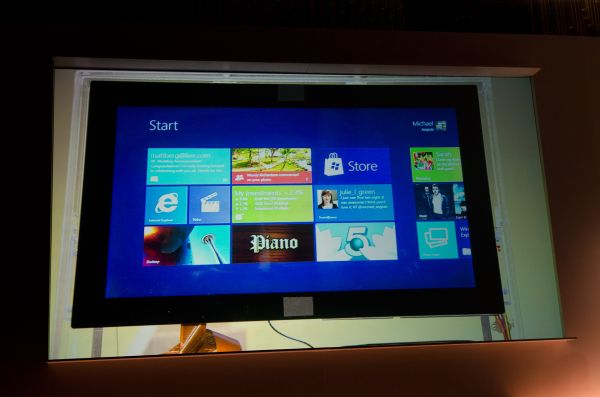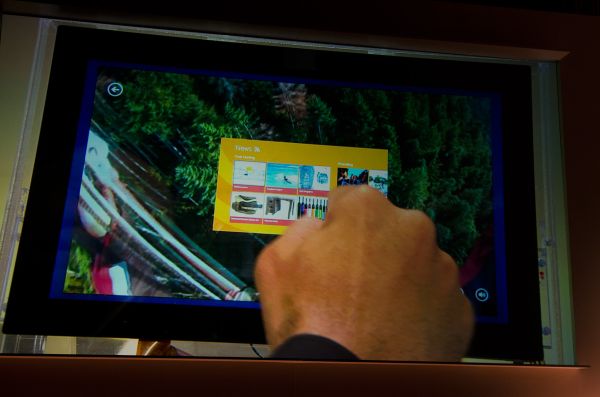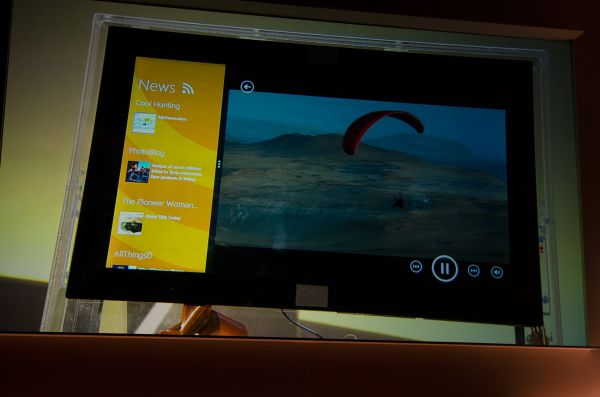This is the Windows 8 Tablet & PC Interface
by Anand Lal Shimpi on June 1, 2011 10:26 PM EST- Posted in
- Trade Shows
- Microsoft
- Computex 2011
- Windows 8
Here's a quick look at the new start screen for Windows 8 running on a Dell XPS Development Tablet. The tablet supports both touch and external keyboard interfaces. The UI is ridiculously smooth, it seems even quicker than Windows Phone 7.
On tablets Windows 8 will support PlayBook like bezel gestures (the gestures actually take place on the first pixel next to the bezel, apparently not in the bezel itself). Gestures for the OS take place on the left/right edges of the screen, while app gestures happen on the top/bottom bezel.
Swipe in from the right to reveal the start button, and swipe in from the left to multitask. You just swipe between active apps like you would on a PlayBook.
The interface doesn't require a touchscreen, Microsoft showed how you can multitask or switch between screens using a keyboard on a standard PC as well. This will be a common interface across all Windows 8 devices, tablet or standard PC.
Tapping the start button switches between the standard Windows desktop and the new tile interface. You can even display multiple applications on the screen at the same time using Windows 8's snap feature.
With a widescreen display (apparently snap isn't supported yet on 4:3s) you can display two apps side by side in the new tablet style UI:
You can even have a standard Windows 8 desktop on one side and a new Windows 8 app on the other.
Microsoft also mentioned that Windows 8 will have the same system requirements or lower vs Windows 7.
Gallery: Windows 8 Tablet & PC Interface



















33 Comments
View All Comments
nofumble62 - Thursday, June 2, 2011 - link
Have they fixed this problem?YuMa-NuMa - Thursday, June 2, 2011 - link
I cannot see how this can be applied to traditional desktops. The OS is based too much on touch interface, I really hope Microsoft can get it right unlike last time when they try to reinvent the UI (Windows Vista) but overall its a bold move to completely change the interface.B3an - Thursday, June 2, 2011 - link
There seems to be so much confusing at the moment about this. I personally dont think this new UI will be used on desktops or laptops by default. I think it's something that can be enabled or disabled, and will be enabled by default on touch devices. Because for desktops this is clearly not a good UI at all, but it's perfect for tablets.Exodite - Thursday, June 2, 2011 - link
I understand that Microsoft has to provide a touch option for their OS going forward and it's only natural that would be related to what they've been working on for Windows Phone.That said...
Microsoft really needs to get their heads out of their ass when it comes to the Windows UI. Every major release of Windows sees a new UI, surprisingly as it may sound that's not a good thing! A consistent UI design is a basic and fundamental building block of an OS.
What I want to hear is more about how they've slimmed the OS down. Have they finally killed the registry? Does the next Windows release get rid of the majority of useless and over-specialized services running in the background of every OS install? Is the OS 64-bit only or will the future still be marginalized? Have legacy compatibility shifted over to a virtual machine yet?
If Windows 8 ends up as Windows 7 with yet another layer tacked on top I might burst a vein.
Spivonious - Thursday, June 2, 2011 - link
You have no idea what the registry is used for if you think they can "kill" the registry. It would break compatibility with almost every application back to Windows 95.I like the new touch UI. MS stated at AllThingsD 9 that the user would still be able to go back to the normal Win7-style desktop after logging in from the new Start Screen. I think the UI they showed is fantastic for tablets and TVs, but for a normal desktop PC the old "desktop" UI paradigm is the best for a mouse and keyboard.
Exodite - Thursday, June 2, 2011 - link
Actually, I know exactly what the registry is for. It's been an exceptional example of poor design decisions from the start and no little source of security concerns.There's no real reason as to why you couldn't get rid of the registry and maintain backwards compatibility, though personally I feel the latter should be shifted out of the main OS and into a VM running it's own XP install or something along those lines anyway.
HMTK - Thursday, June 2, 2011 - link
Kill the registry = kill Group Policy. Unlikely to happen Any Time Soon.63jax - Thursday, June 2, 2011 - link
i'm pretty sure they wont fail with this, this was their main focus on win8cobular - Thursday, June 2, 2011 - link
@sprockketsit has already been stated that there will be no support for x86 apps on the ARM version, expect some kind of third party virtual machine though. Compatibility is generally only a business decision (consumers can buy new/updated apps) thus microsoft doesnt want to invest.
@remote control
Microsoft offers a lot of cloud services but are not got at getting people to know about them the live suite, the cloud drive, mesh service and office online, combined you can have your mail, movies, pictures, documents and any other file you want available to any internet connected device and integrated into every windows system with app installations. Best of all they are all FREE and allow collaboration even simultaneously on windows installations for documents.
mino - Thursday, June 2, 2011 - link
It is NOT free.You pay for it with you privacy.